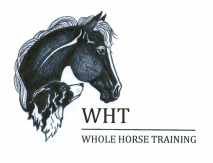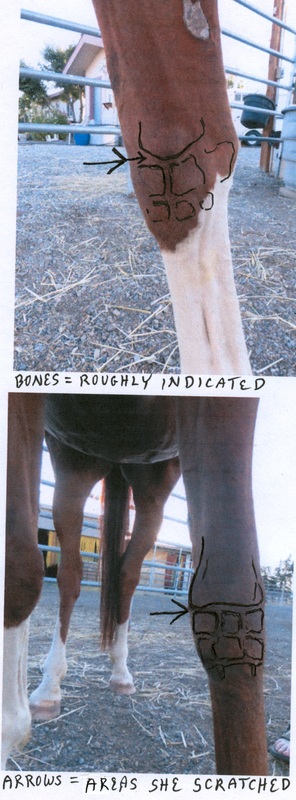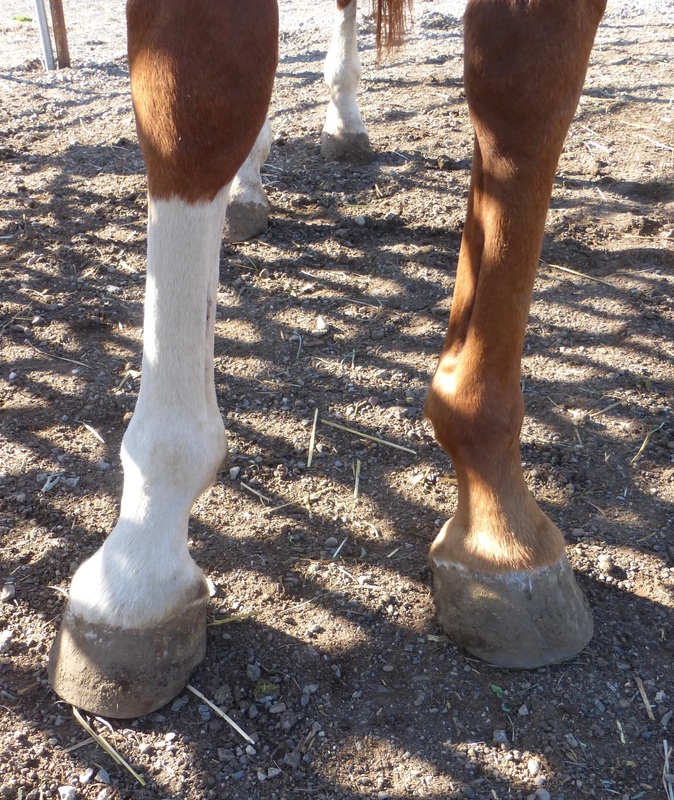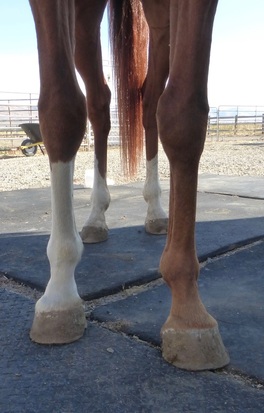Stress in Jillie’s knees?
After returning from a 3 week vacation I went out to check on Jillie and resume the physical therapy exercises (see video) I had been doing to encourage her front legs to straighten. I noticed the hair was being rubbed off on the inside of both of her knees. I was puzzled. It seemed such a difficult spot to rub, that I said out loud, “What in the world could you find to rub on here?” I no sooner said it, than she extended a front leg and began scratching on one of the spots with her teeth.
Off to the anatomy books! I determined that she was chewing the inside (medial side) of the antebrachiocarpal joint, specifically the base of the radius and the RC, radial carpal, bone on both front legs. Great. Now that it had a name what did this tell me? The only information I could find that specifically discussed this joint, was an article about a study of OA, osteoarthritis, in riding horses and I think it may have guided me onto the right track. *
In a discussion about the function of the joint, I was fascinated to learn that in movement the bones in the knee are mobile and the different joints within the carpal joint do not fit perfectly but slide into position when loaded. I swear! Horses are so fascinating! The ability of carpal joint surfaces to dissipate force by transfer to certain ligaments is the principal means by which carpal injury is avoided. Repetitive trauma and/or an impact load to the joint tissues can cause degenerative changes in these joints. Initially, there are lesions and erosion or loss of cartilage. Debris from these lesions is linked together with bony changes that create stiff, inelastic tissue and causes a low-grade synovitis, which contributes to the development and progression of OA. Early in the development of the disease, lameness is not necessarily present. *
Suddenly, my joyful response to the improvement I saw in the toe-out twist in Jillie’s front legs was dampened by what I now perceived as signs of stress in her ligaments. Might the correction of the twist in her front legs and/or the increase in the range of motion of her shoulders be causing discomfort or unfavorable changes in the joints in her knees? The article I had found said that horses who develop OA, osteoarthritis, present with shortened stride and decreased shoulder action. What affect was dramatically increasing the range of motion in Jillie’s shoulders having?
I talked to a couple of vets and they agreed that the changes occurring in Jillie’s posture could stress the ligaments. She didn’t seem painful when the joints were flexed, but the chewing indicates that she is aware of some sensation in her knees. One vet recommended x-rays, the other said wait and see what happens. I’m not big on spending money on diagnostics when answers to my questions don’t necessarily hang in the balance, so I decided x-rays could wait.
I also decided to treat the area as if it were painful. Topically, I soaked the area with Sore-No-More liniment and an herbal preparation my friend made. And I put her on the Silver Lining Equine Herbal formula #12 Feet & Bone Support**, which is recommended for the following conditions:
Anything is possible. I believe that Jillie’s joints were stressed and at risk in the extreme toe-out position and, my hopes are that the discomfort is a good sign because things are changing significantly and that these 4 year-old joints are resilient enough to adjust favorably.
* http://www.ncbi.nlm.nih.gov/pmc/articles/PMC2203221/
** https://www.silverliningherbs.com/product/12-feet-bone-support/
UPDATE: As of SEPTEMBER 8th
Jillie had the hair on her knees so damaged that it was difficult to determine when she stopped chewing on them, but I can say with certainty that as of September 8th, the hair is smoother and I don’t see any signs that she is continuing to chew on her knees. YES!
She is putting up a winter coat so I can watch for signs of chewing on a clean slate.
With 20/20 hindsight, I feel it was good for me to be away for 3 weeks and let Jillie rest so the effects of all the bodywork and exercises could “cook.” Had I been home, I may have pushed too hard in my eagerness to encourage change. It’s that Equine Standard Time thing.
I also want to make it clear that I work her very little and offer continual support to her body with brief and/or extensive bodywork sessions.
SEPTEMBER 17th
After returning from a 3 week vacation I went out to check on Jillie and resume the physical therapy exercises (see video) I had been doing to encourage her front legs to straighten. I noticed the hair was being rubbed off on the inside of both of her knees. I was puzzled. It seemed such a difficult spot to rub, that I said out loud, “What in the world could you find to rub on here?” I no sooner said it, than she extended a front leg and began scratching on one of the spots with her teeth.
Off to the anatomy books! I determined that she was chewing the inside (medial side) of the antebrachiocarpal joint, specifically the base of the radius and the RC, radial carpal, bone on both front legs. Great. Now that it had a name what did this tell me? The only information I could find that specifically discussed this joint, was an article about a study of OA, osteoarthritis, in riding horses and I think it may have guided me onto the right track. *
In a discussion about the function of the joint, I was fascinated to learn that in movement the bones in the knee are mobile and the different joints within the carpal joint do not fit perfectly but slide into position when loaded. I swear! Horses are so fascinating! The ability of carpal joint surfaces to dissipate force by transfer to certain ligaments is the principal means by which carpal injury is avoided. Repetitive trauma and/or an impact load to the joint tissues can cause degenerative changes in these joints. Initially, there are lesions and erosion or loss of cartilage. Debris from these lesions is linked together with bony changes that create stiff, inelastic tissue and causes a low-grade synovitis, which contributes to the development and progression of OA. Early in the development of the disease, lameness is not necessarily present. *
Suddenly, my joyful response to the improvement I saw in the toe-out twist in Jillie’s front legs was dampened by what I now perceived as signs of stress in her ligaments. Might the correction of the twist in her front legs and/or the increase in the range of motion of her shoulders be causing discomfort or unfavorable changes in the joints in her knees? The article I had found said that horses who develop OA, osteoarthritis, present with shortened stride and decreased shoulder action. What affect was dramatically increasing the range of motion in Jillie’s shoulders having?
I talked to a couple of vets and they agreed that the changes occurring in Jillie’s posture could stress the ligaments. She didn’t seem painful when the joints were flexed, but the chewing indicates that she is aware of some sensation in her knees. One vet recommended x-rays, the other said wait and see what happens. I’m not big on spending money on diagnostics when answers to my questions don’t necessarily hang in the balance, so I decided x-rays could wait.
I also decided to treat the area as if it were painful. Topically, I soaked the area with Sore-No-More liniment and an herbal preparation my friend made. And I put her on the Silver Lining Equine Herbal formula #12 Feet & Bone Support**, which is recommended for the following conditions:
- For healthy strong bones, tendons, ligaments, and surrounding tissues
- Helping maintain strong bones, tendons, and ligaments
- Helping reduce free radical formation
- Maintaining normal circulation to the limbs
Anything is possible. I believe that Jillie’s joints were stressed and at risk in the extreme toe-out position and, my hopes are that the discomfort is a good sign because things are changing significantly and that these 4 year-old joints are resilient enough to adjust favorably.
* http://www.ncbi.nlm.nih.gov/pmc/articles/PMC2203221/
** https://www.silverliningherbs.com/product/12-feet-bone-support/
UPDATE: As of SEPTEMBER 8th
Jillie had the hair on her knees so damaged that it was difficult to determine when she stopped chewing on them, but I can say with certainty that as of September 8th, the hair is smoother and I don’t see any signs that she is continuing to chew on her knees. YES!
She is putting up a winter coat so I can watch for signs of chewing on a clean slate.
With 20/20 hindsight, I feel it was good for me to be away for 3 weeks and let Jillie rest so the effects of all the bodywork and exercises could “cook.” Had I been home, I may have pushed too hard in my eagerness to encourage change. It’s that Equine Standard Time thing.
I also want to make it clear that I work her very little and offer continual support to her body with brief and/or extensive bodywork sessions.
SEPTEMBER 17th
It is so difficult to get good pictures of her stance. Angles vary vastly and as soon as she sees the camera, she starts walking toward it to put her nose on it. (Misguided Clicker Training effort?) I try to capture shots where she is on her own so I haven’t had any influence over the way her toes turn.
These photos were both taken September 17th, about 20 minutes apart. (Left) You can see that Jillie’s stance varies and she still toes out, but (right) she sometimes stands with her toes much less out and this is why I am so encouraged by the changes she is making. I believe that if I continually support correct posture throughout her body and support it with slow, deliberate movement that emphasizes releasing, her legs will straighten.
It is amazing that this horse showed up in my life just when I was starting to question how much of a horse’s conformation was real and how much was influenced by postural compensations.
These photos were both taken September 17th, about 20 minutes apart. (Left) You can see that Jillie’s stance varies and she still toes out, but (right) she sometimes stands with her toes much less out and this is why I am so encouraged by the changes she is making. I believe that if I continually support correct posture throughout her body and support it with slow, deliberate movement that emphasizes releasing, her legs will straighten.
It is amazing that this horse showed up in my life just when I was starting to question how much of a horse’s conformation was real and how much was influenced by postural compensations.




 RSS Feed
RSS Feed